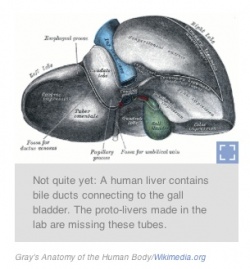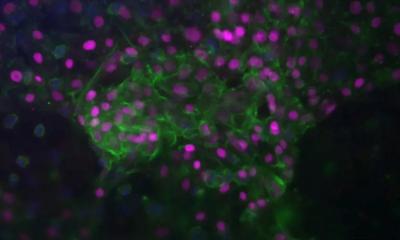Scientists Grow A Simple, Human Liver In A Petri Dish
Japanese scientists have cracked open a freaky new chapter in the sci-fi-meets-stem-cells era. A group in Yokohama reported it has grown a primitive liver in a petri dish using a person's skin cells.


The organ isn't complete. It's missing a few parts. And it will be years — maybe decades — before the technique reaches clinics. Still, this rudimentary liver is the first complex, functioning organ to be grown in the lab from human, skin-derived stem cells. When the scientists transplanted the organ into a mouse, it worked a lot like a regular human liver. "It's a huge step forward," George Daley, from the Harvard Stem Cell Institute, tells NPR's Rob Stein.
"There have been groups that have attempted to generate liver cells, and that's been promising," says Daley, who wasn't involved in the current study. "This is the first attempt to regenerate the organ by mixing the cells that are critical components of that organ." Several labs around the world have been trying to grow organs on plastic scaffolds, which offer a three-dimensional surface on which cells can stick. This approach has been used to make tracheas from a person's own cells. And doctors have even transplanted these synthetic organs into a handful of patients.
But more complex organs – kidneys, pancreases and livers – have been elusive. So Takanori Takebe and a team at the Yokohama City University tried a more laid-back strategy: They let the cells build their own scaffold. The team took some liver cells (made from a person's induced pluripotent stem cells) and then mixed them with two other cell types — one that makes blood vessels and one that builds connective tissue to hold an organ together. Five days later, Takebe was "completely gobsmacked," by what he saw in the petri dish, he told reporters Tuesday, with the help of a translator. The cell mixtures had assembled into tiny 3-D structures that looked and acted like miniature livers, or "liver buds," as Takebe calls them.
The proto-organs were only about 5 millimeters tall, or half the height of a Lego brick. But the liverettes built their own blood vessels, which allowed Takebe and his team to test-drive them in mice. They plucked the liver buds from the petri dish and then connected them to blood vessels in a mouse. About 10 days later, the buds started working. They broke down human drugs and made blood proteins, as a regular liver would. One proto-organ even saved a mouse from liver failure, Takebe and his colleagues report in the journal Nature. The results are "extremely encouraging," says stem-cell scientist Stuart Forbes, from the University of Edinburgh. "But there's a significant amount of further research [required] before we could translate this to a clinical therapy for patient," he tells Stein. First off, the organs are too small to be useful. Doctors would need thousands of them to help a person with liver damage. And the little buds don't form a full liver. They're missing bile ducts, or the tubes that drain away toxins.
Plus, Forbes says, there's still a big question about safety. Stem cells tend to form tumors. And the current study doesn't look at the long-term effect of the transplanted liver. "To perform this in humans, we'd like to see a lot of safety testing," Forbes says.
09.07.2013








